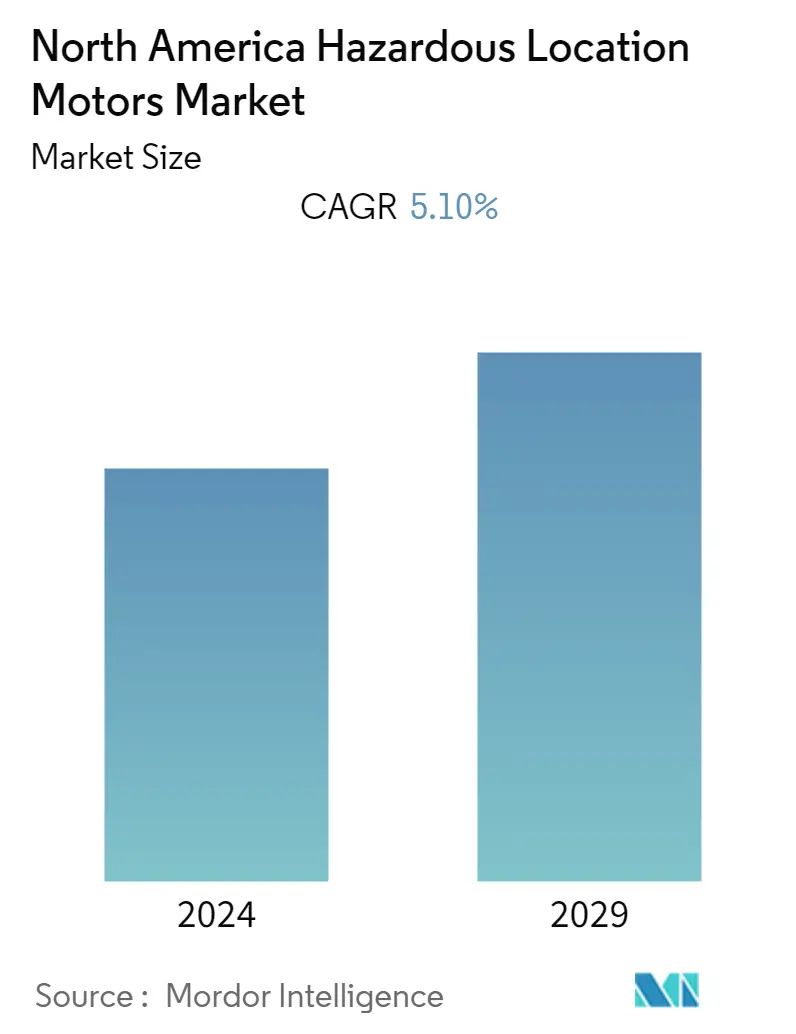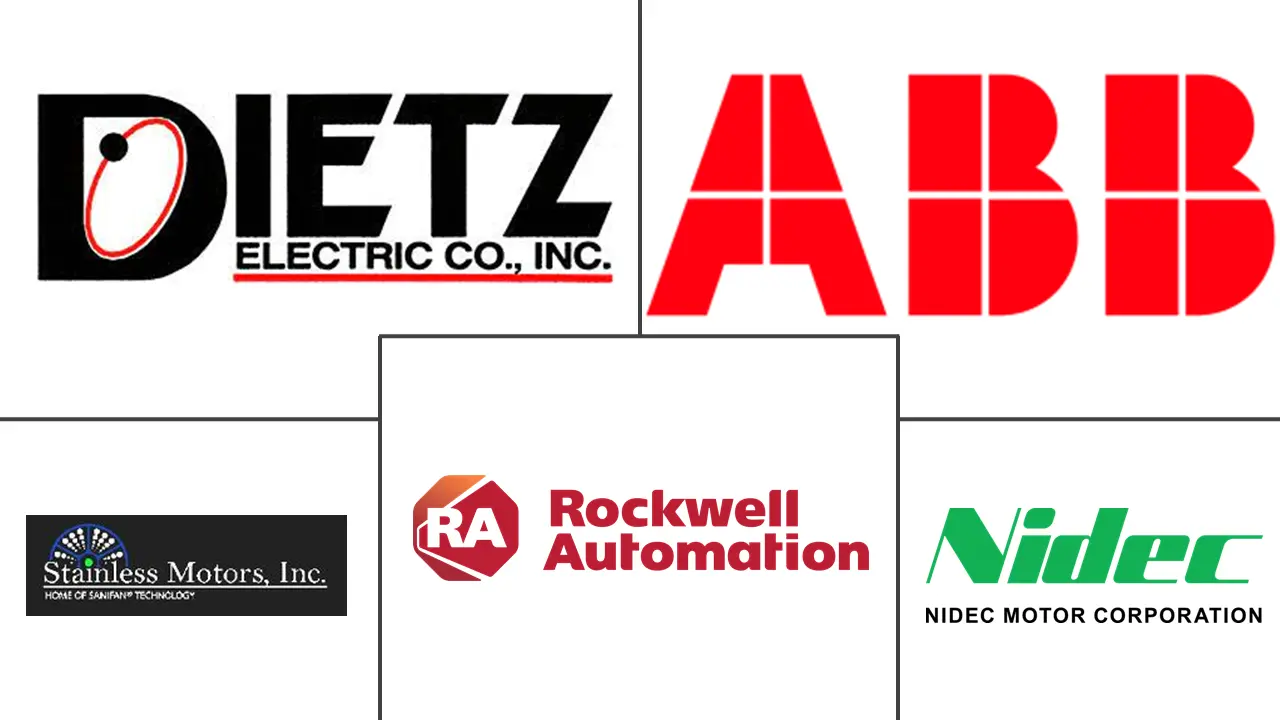Market Size of North America Hazardous Location Motors Industry

| Study Period | 2019 - 2029 |
| Base Year For Estimation | 2023 |
| Forecast Data Period | 2024 - 2029 |
| Historical Data Period | 2019 - 2022 |
| CAGR | 5.10 % |
| Market Concentration | Medium |
Major Players
*Disclaimer: Major Players sorted in no particular order |
North America Hazardous Location Motors Market Analysis
The North America Hazardous Location Motors Market is expected to register a CAGR of 5.1% during the forecast period (2021-2026). The strict rules & regulations regarding hazardous areas and safety in the workplace, defined in the NEC articles in the USA, have rendered significant impetus to the growth of the hazardous location motors market in the North American region.
- The use of explosion-proof motors, which are designed for use in hazardous environments where flammable gases, dust, or fibers are present, is essential for the safety of personnel and equipment. Electric motors generate heat under standard operating conditions and can generate a spark if a motor coil fails. Excessive motor case temperatures or an inadequately contained spark can cause an explosion or ignite a fire in environments where specific hazardous materials are present.
- The grain and milling industries are among the most common facilities for dust explosions. Flour might seem harmless, but when it is distributed in the air in high concentrations, combined with an ignition source, confined space, dispersion, and oxygen, it causes an explosion. Flour mills have been an essential part of the American economy and the region's agricultural industry. The increasing production of flour in the North American region acts as a catalyst for the growth of the studied market.
- For instance, wheat flour production by US flour mills in 2020 totaled 425.338 million cwts, up by 3.061 million cwts, or 0.7%, from 422.277 million cwts in 2019, according to the National Agricultural Statistics Service (NASS) of the US Department of Agriculture.
- Further, cocoa powder is widely used in the region's confectioneries and bakeries. The grinding process of cocoa falls under strict regulations in the North American region, due to which the penetration of the explosion-proof motor is high. In reviewing the global incident data, food and wood products made up over 75% of the combustible dust fires and explosions recorded in the North American Region. According to the National Confectioners Association (NCA), in 2021, cocoa grindings featured an increase of 2.05%, from 1,15,591 tonnes in 2020 to 1,17,956 tonnes in 2021. The rising demand and production of cocoa are also aiding the market growth in the region.
- However, designing and manufacturing motors that completely engulf an internal explosion without rupturing or passing out any hot gases from the enclosure so that they are forced to exit through a long, narrow opening known as flame paths are the two major challenges faced by hazardous location motors market. Further, the Covid-19 pandemic has also posed several challenges to the studied market, like disruption in the supply chain and increased raw materials prices.
North America Hazardous Location Motors Industry Segmentation
The North America Hazardous Location Motors Market is Segmented by Type (Explosion-Proof General Purpose Motors, Drill Rig Duty Motors, Explosion-Proof Pump Motors, Explosion-Proof Inverter Duty Motors, Explosion-Proof Severe Duty Motors), Class (Class I, Class II, Class III), Division (Division 1, Division 2), Zone ( Zone 0, Zone 1, Zone 21, Zone 2, Zone 22), Applications (Spray Painting and Finishing Areas, Petroleum Refining Plants, Dry Cleaning Facilities, Utility Gas Plants, Grain Elevators and Grain Handling Facilities, Flour Mills, Aluminum Manufacturing and Storage Areas, Fire Work Plants and Storage Areas, Confectionary Plants), and Country.
Hazardous location motors are intended to improve workplace safety by containing explosions within the motor. Different motors are used to meet the needs of various settings and applications. Class I motors are used for settings concerning gases, vapors, or liquids, while Class II motors are intended for areas containing dust, flammable lint, or fibers in the area, such as textile, sawdust, etc. Further, combustible elements are always present or are present regularly in Division I locations, and In Division II locations, they are found in operator-handled containers or storage tanks that could spill or leak in the event of equipment failure.
| By Type | |
| Explosion-Proof General Purpose Motors | |
| Drill Rig Duty Motors | |
| Explosion-Proof Pump Motors | |
| Explosion-Proof Inverter Duty Motors | |
| Explosion-Proof Severe Duty Motors |
| By Class | |
| Class I | |
| Class II | |
| Class III |
| By Division | |
| Division 1 | |
| Division 2 |
| By Zone | |
| Zone 0 | |
| Zone 1 | |
| Zone 21 | |
| Zone 21 | |
| Zone 22 |
| By Applications | |
| Spray Painting and Finishing Areas | |
| Petroleum Refining Plants | |
| Dry Cleaning Facilities | |
| Utility Gas Plants | |
| Grain Elevators and Grain Handling Facilities | |
| Flour Mills | |
| Aluminum Manufacturing and Storage Areas | |
| Fire Work Plants and Storage Areas | |
| Confectionary Plants | |
| Other Applications |
| By Country | |
| United States | |
| Canada | |
| Rest of North America |
North America Hazardous Location Motors Market Size Summary
The North America Hazardous Location Motors Market is experiencing growth driven by stringent safety regulations and the need for explosion-proof motors in hazardous environments. These motors are crucial for ensuring safety in industries such as grain milling, cocoa processing, and oil and gas, where the presence of flammable materials poses significant risks. The market is supported by the increasing production of flour and cocoa, which necessitates the use of specialized motors to prevent dust explosions. Additionally, the oil and gas sector, with its demanding operational conditions, relies heavily on these motors to maintain safety and efficiency. The region's robust production and export activities in these industries further bolster the market's expansion.
Despite the growth prospects, the market faces challenges, including the complexities of designing motors that can withstand internal explosions without releasing hot gases. The COVID-19 pandemic has also impacted the market by disrupting supply chains and increasing raw material costs. However, the adoption of class-I and class-II hazardous location motors, which are designed to operate safely in environments with combustible gases and dust, is on the rise. The market is moderately competitive, with key players focusing on technological advancements and strategic partnerships to enhance their market presence. As industries continue to prioritize safety and compliance with regulations, the demand for hazardous location motors is expected to remain strong in North America.
North America Hazardous Location Motors Market Size - Table of Contents
-
1. MARKET INSIGHTS
-
1.1 Market Overview
-
1.2 Industry Attractiveness - Porter's Five Forces Analysis
-
1.2.1 Bargaining Power of Suppliers
-
1.2.2 Bargaining Power of Consumers
-
1.2.3 Threat of New Entrants
-
1.2.4 Threat of Substitute Products
-
1.2.5 Intensity of Competitive Rivalry
-
-
1.3 Technology Snapshot
-
1.4 Assessment of the Impact of COVID-19
-
-
2. MARKET SEGMENTATION
-
2.1 By Type
-
2.1.1 Explosion-Proof General Purpose Motors
-
2.1.2 Drill Rig Duty Motors
-
2.1.3 Explosion-Proof Pump Motors
-
2.1.4 Explosion-Proof Inverter Duty Motors
-
2.1.5 Explosion-Proof Severe Duty Motors
-
-
2.2 By Class
-
2.2.1 Class I
-
2.2.2 Class II
-
2.2.3 Class III
-
-
2.3 By Division
-
2.3.1 Division 1
-
2.3.2 Division 2
-
-
2.4 By Zone
-
2.4.1 Zone 0
-
2.4.2 Zone 1
-
2.4.3 Zone 21
-
2.4.4 Zone 21
-
2.4.5 Zone 22
-
-
2.5 By Applications
-
2.5.1 Spray Painting and Finishing Areas
-
2.5.2 Petroleum Refining Plants
-
2.5.3 Dry Cleaning Facilities
-
2.5.4 Utility Gas Plants
-
2.5.5 Grain Elevators and Grain Handling Facilities
-
2.5.6 Flour Mills
-
2.5.7 Aluminum Manufacturing and Storage Areas
-
2.5.8 Fire Work Plants and Storage Areas
-
2.5.9 Confectionary Plants
-
2.5.10 Other Applications
-
-
2.6 By Country
-
2.6.1 United States
-
2.6.2 Canada
-
2.6.3 Rest of North America
-
-
North America Hazardous Location Motors Market Size FAQs
What is the current North America Hazardous Location Motors Market size?
The North America Hazardous Location Motors Market is projected to register a CAGR of 5.10% during the forecast period (2024-2029)
Who are the key players in North America Hazardous Location Motors Market?
Stainless Motors, Inc., Dietz Electric Co., Inc., Rockwell Automation, Inc. , Nidec Motor Corporation and ABB Ltd are the major companies operating in the North America Hazardous Location Motors Market.

